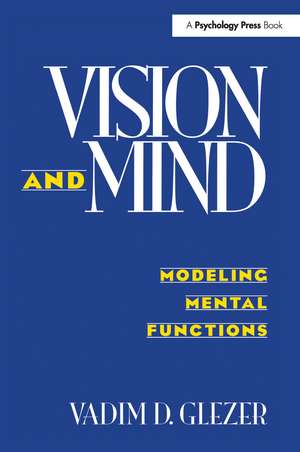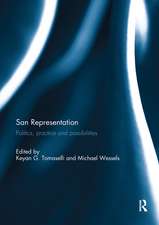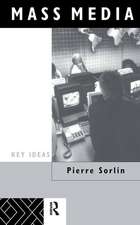Vision and Mind: Modeling Mental Functions
Autor Vadim D. Glezeren Limba Engleză Paperback – 6 sep 2016
This book approaches the problem of the organization of higher psychological functions a different way -- by analyzing the functional organization of the neural structures that gradually form universal categories from "raw" sensory material. At the higher levels of the brain's operation, these universals correspond to the basic categories of thought and language. The visual system provides rewarding material for such an approach, both because it is relatively well researched and because it is the main source of sensory information in humans. With this in mind, this monograph examines the whole process of the transformation and description -- the coding of visual information. The most important aspect of this process is the transition from the description of visual space to the description of individual objects and the relationships between them. This transition is made possible by the existence in the visual system of various mechanisms that developed during evolution as a result of environmental influences.
Written for a wide circle of investigators in disciplines associated with different aspects of the functioning of the brain -- physiologists and psychologists -- this book is also of importance to engineers and mathematicians working on the problems of artificial intelligence, and linguists and philosophers interested in the deep structures that form the universals of thought and language.
Preț: 148.43 lei
Preț vechi: 185.59 lei
-20% Nou
Puncte Express: 223
Preț estimativ în valută:
28.41€ • 30.87$ • 23.88£
28.41€ • 30.87$ • 23.88£
Carte tipărită la comandă
Livrare economică 22 aprilie-06 mai
Preluare comenzi: 021 569.72.76
Specificații
ISBN-13: 9781138986787
ISBN-10: 113898678X
Pagini: 290
Dimensiuni: 152 x 229 mm
Greutate: 0.45 kg
Ediția:1
Editura: Taylor & Francis
Colecția Psychology Press
Locul publicării:Oxford, United Kingdom
ISBN-10: 113898678X
Pagini: 290
Dimensiuni: 152 x 229 mm
Greutate: 0.45 kg
Ediția:1
Editura: Taylor & Francis
Colecția Psychology Press
Locul publicării:Oxford, United Kingdom
Public țintă
ProfessionalCuprins
Contents: Introduction. Processing of Visual Signals in the Retina and the LGN. The Receptive Fields of the Striate Cortex. The Modules of the Visual Cortex: Neurophysiological Investigations. Piecewise Fourier Analysis: Psychophysical and Behavioral Evidence. The Primary Segmentation of Visual Space. The Prestriate and Peristriate Cortices and Their Functions. The Two Basic Visual Mechanisms. Pattern Recognition and the Functions of the ITC. The Description of Spatial Relations and the Functions of the PPC. Hemispheric Assymetry and Visual Recognition. A Hypothesis and Model of the Higher Divisions of the Visual Brain: The Double Dichotomy of the Visual Brain. A Perceptual Model of the World.
Recenzii
"...this book would be excellent reading for anyone interested in understanding of the mental functioning in terms of brain structure and the mechanisms that perform certain operations."
—Roeper Review
"During the 1970s, great strides were made in our understanding of the brain functions necessary for visual form perception. Much of this work was done in English-speaking countries and was, therefore, readily accessible to the Western scientific community. One exception was the research undertaken by Vadim Glezer and his colleagues in Leningrad (now St. Petersburg). Most of those studies were reported in Russian, but gradually some of us began to be acquainted with them. At first, it seemed that the Russian work simply paralleled that performed elsewhere; that, in itself, would have been sufficient reason for translating this work, because it would show that experimenters from different backgrounds were obtaining the same results. However, it turned out that this work represented a much richer vein of data and interpretation that had become available for mining.
Glezer's laboratory contributions are fresh and his interpretations of the brain's harmonic analysis of form vision add considerably to our understanding. The English-speaking community should, therefore, welcome this solid contribution to our understanding of the visual process as it relates to the brain, on the one hand, and to cognition, on the other."
—Karl H. Pribram
Professor Emeritus, Stanford University, James P. and Anna King University Profe
—Roeper Review
"During the 1970s, great strides were made in our understanding of the brain functions necessary for visual form perception. Much of this work was done in English-speaking countries and was, therefore, readily accessible to the Western scientific community. One exception was the research undertaken by Vadim Glezer and his colleagues in Leningrad (now St. Petersburg). Most of those studies were reported in Russian, but gradually some of us began to be acquainted with them. At first, it seemed that the Russian work simply paralleled that performed elsewhere; that, in itself, would have been sufficient reason for translating this work, because it would show that experimenters from different backgrounds were obtaining the same results. However, it turned out that this work represented a much richer vein of data and interpretation that had become available for mining.
Glezer's laboratory contributions are fresh and his interpretations of the brain's harmonic analysis of form vision add considerably to our understanding. The English-speaking community should, therefore, welcome this solid contribution to our understanding of the visual process as it relates to the brain, on the one hand, and to cognition, on the other."
—Karl H. Pribram
Professor Emeritus, Stanford University, James P. and Anna King University Profe























